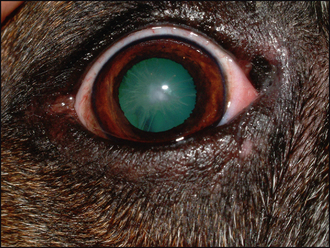41 Cataract in a young dog
CASE HISTORY
In most cases there is no previous history of ocular disease or relevant systemic disease. In pedigree dogs, especially those breeds listed in Table 41.1, the owner should be asked whether the sire and dam had their eyes tested prior to breeding. Unfortunately this is not performed as often as one would like and, as such, there is a fairly high incidence of inherited cataract in some breeds of pedigree dog.
Table 41.1 Inherited cataracts in dogs (UK list)
| Type of cataract/inheritance | Breed |
|---|---|
| Congenital | Miniature schnauzer |
| Early onset with progression | |
| Posterior polar (upside down ‘Y’ or triangle) | |
| Sometimes progressive | |
| Other forms | |
| Suspected to be inherited |
CLINICAL EXAMINATION
General clinical examination is normally unremarkable. On ophthalmic examination menace responses can be normal or reduced. Pupillary light reflexes are usually normal (providing no retinal disease is present – the breeds which suffer from inherited cataracts can also suffer from progressive retinal atrophy). Unless the lenses have suddenly developed maturing cataracts there is unlikely to be any ocular inflammation, but evidence of episcleral congestion, iris darkening or thickening, and mild miosis can suggest lens-induced uveitis. Opacification of one or both lenses will be apparent on distant direct ophthalmoscopy and can be examined in more detail with the direct ophthalmoscope at a setting of +8 to +12D (Figure 41.1).
Stay updated, free articles. Join our Telegram channel

Full access? Get Clinical Tree



